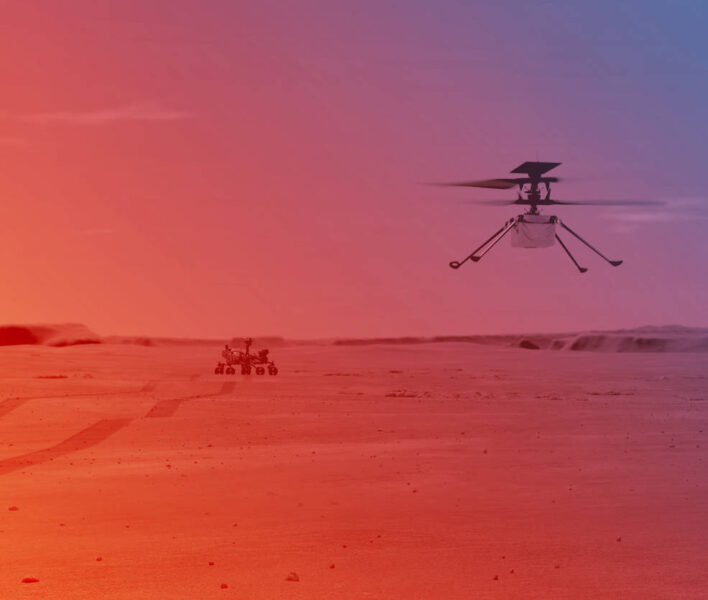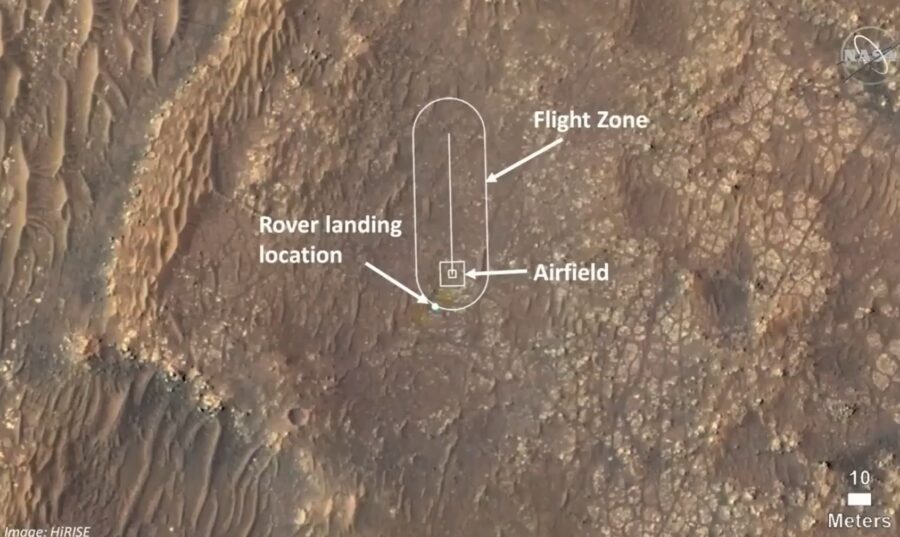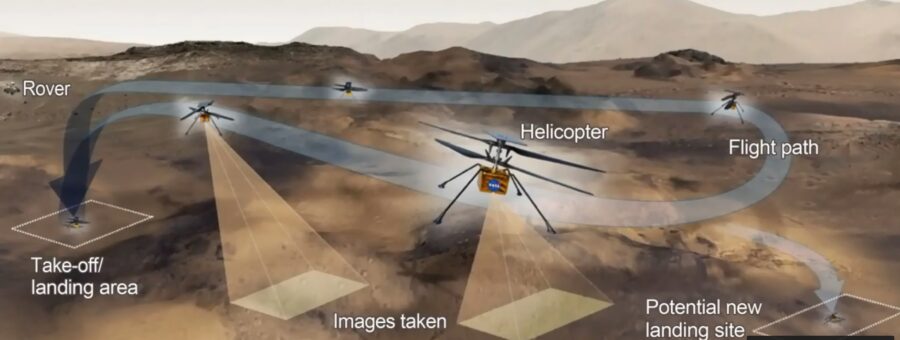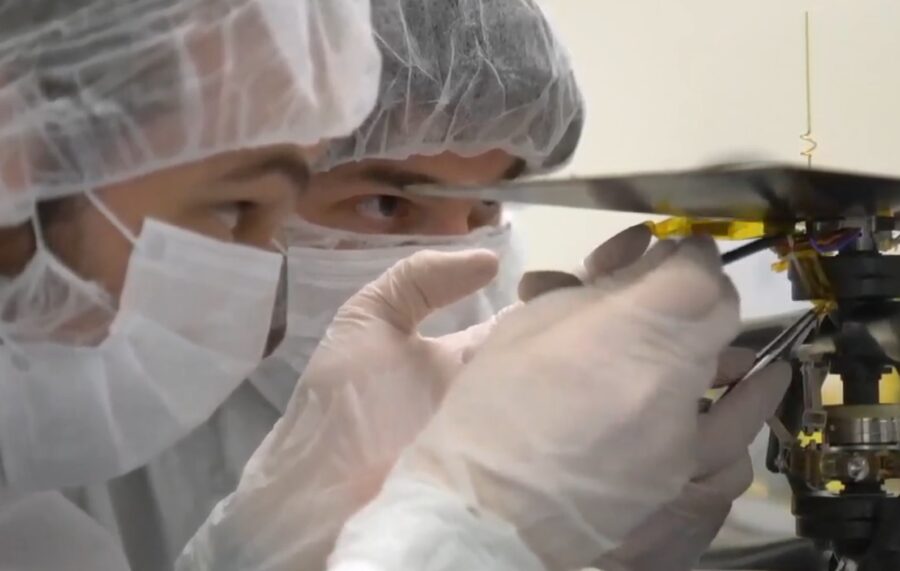NASA readies to deploy Ingenuity, the first helicopter mission to take to alien skies.

NASA / JPL-Caltech
A long-awaited first in planetary spaceflight may soon come to pass, as NASA readies the Ingenuity Mars Helicopter, currently stowed on the Perseverance Mars rover for its first flight no earlier than April 8th.
Preparing to Deploy Ingenuity
Perseverance landed on Mars in Jezero Crater on February 18th at the newly named Octavia E. Butler Landing Site. The 4-pound (1.8-kilogram) Ingenuity helicopter is stowed on the rover's underside. Thus far, the team has been testing the charge capabilities for Ingenuity while it’s still in the stowed position. Once it’s released from the plutonium-fueled rover, the solar-powered helicopter is on its own.
“As with everything with the helicopter, this type of deployment has never been done before,” says Farah Alibay (NASA-JPL) in a recent press release. “Once we start the deployment there is no turning back.”
Though gravity on Mars is about a third of Earth’s, presumably making flight easier, the atmosphere is also thin, about a hundredth of Earth’s air pressure at sea level. The rarefied air presents a challenge to the flying helicopter, which carries four carbon-fiber blades, arranged in counterrotating pairs. They spin at 2,537 rpm — about four times faster than passenger helicopters on Earth.
The team dropped the protective debris shield this past weekend on Sunday, March 21st, exposing the helicopter. Now, the team must drive Perseverance to the pre-selected “helipad” deployment site.The team hopes to complete up to five flights over a month in April.
Away goes the debris shield, and here’s our first look at the helicopter. It’s stowed sideways, folded up and locked in place, so there’s some reverse origami to do before I can set it down. First though, I’ll be off to the designated “helipad,” a couple days’ drive from here. pic.twitter.com/E9zZGQk5jQ
— NASA's Perseverance Mars Rover (@NASAPersevere) March 21, 2021
What will follow is a sequence of critical deployment events carried out over six Martian days (6 sols) that will bring Ingenuity from a horizontal position under the rover to vertical on the ground. This process includes activation of a bolt-breaker to release the helicopter on sol 1, then firing pyrotechnics on sol 2to allow a mechanized arm to swing Ingenuity from horizontal to vertical, allowing it to extend two of its four landing legs for the first time.
On sol 3, a motor will finish rotating Ingenuity to the horizontal position, while it extends the second pair of legs. The legs will snap into position on sol 4.
Perseverance’s Wide Angle Topographic Sensor for Operations and eNgineering (WATSON) will document the process, confirming that each step has been carried out. Right before deployment completes, the rover will take the final opportunity to top up the charge on the helicopter's six battery cells. Ingenuity will drop the last 5 inches (13 centimeters) to the Martian surface. Then, it's on its own.

NASA/MRO/HiRISE
The deployment site represents the first “airfield” on another planet. Shortly after landing and surveying the region around Perseverance, engineers realized they had a potential deployment site, straight ahead and in front of the rover, where the land was flat and relatively free of debris.
The deployment timeline will see the first flight not earlier than April 8th, though that could change a few days in either direction as conditions allow.
Once deployed, the rover will back off 330 feet (100 meters) within 25 hours to allow Ingenuity’s solar panels exposure to sunlight. The retreat also puts Perseverance at a safe distance in preparation for documenting the first flight. Ingenuity will them complete a series of spin-up tests.
The preselected parking point from which Perseverance will watch the first flight of Ingenuity was formally named the Jakob van Zyl Overlook. This honors NASA-JPL Director for Solar System Exploration Jakob van Zyl, who passed away unexpectedly last year, about a month after the launch of Perseverance. Ingenuity was one of the last projects that van Zyl worked on.
The Mars Environmental Dynamics Analyzer (MEDA) instrument aboard Perseverance will analyze wind and weather patterns ahead of the first flight. The go/no-go decision will be made the day before, and commands will be uploaded to Ingenuity around the same time.

NASA / JPL-Caltech
During the first short flight, Ingenuity will take off, fly to a modest altitude of just three meters, hover, then land. Ingenuity will take about 30 images per second while in flight, including the first-ever “remote rover selfie” on the ground, while Perseverance images Ingenuity in flight. Ingenuity will stay within a 50-foot long oval patch during initial flight tests.
What’s Aboard Ingenuity
“Ingenuity is an experimental engineering flight test — we want to see if we can fly at Mars,” says MiMi Aung (NASA-JPL). "There are no science instruments onboard and no goals to obtain scientific information. We are confident that all the engineering data we want to obtain both on the surface of Mars and aloft can be done within this 30-sol window.”

NASA / JPL-Caltech
Ingenuity does carry inertial sensors, a laser altimeter, and two cameras: a 13-megapixel color camera and a 0.5-megapixel black-and-white navigation camera. Ingenuity also has internal heaters to withstand the cold Martian nights.
There’s also a piece of fabric from the original 1903 Wright Flyer aboard Ingenuity, a swatch about the size of a postage stamp.

NASA / JPL-Caltech
The helicopter's performance was tested in a vacuum chamber at the Jet Propulsion Laboratory on Earth, and the deployment and flight sequence was tested at JPL’s famous Mars Yard. Cost for design, development and construction for Ingenuity was $85 million.
Future helicopters could become standard aboard planetary missions to scout terrain ahead, look into shadowed craters, and more. While Ingenuity's mission is a short proof of concept, it's only the beginning. NASA plans on sending a much more ambitious nuclear-powered helicopter named Dragonfly to Saturn’s large moon Titan, perhaps launching by 2027.
April will truly be the “month of Ingenuity” as the historic interplanetary helicopter is about to take flight.
 2
2









Comments
Andrew James
March 24, 2021 at 1:08 am
Pray there is no sudden breeze, else it'll be very disappointing!
You must be logged in to post a comment.
Don-Kerouac
March 28, 2021 at 11:12 am
Fortunately, the "air" on Mars is so thin, it imparts little energy, though as a pilot, I'd still like a good weather briefing before flight! 🙂
After all, pound for pound, this may be the most valuable craft ever flown!
You must be logged in to post a comment.
You must be logged in to post a comment.